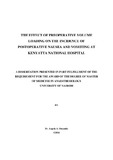| dc.description.abstract | Background: Nausea and vomiting in the postoperative period occurs in 20% to 30% of patients and together are the second most common complaints reported (pain is the most common). While the experience of PONV is self-limiting, postoperative vomiting /retching (POV/R) can lead to rare but serious medical complications, such as aspiration of gastric contents, wound dehiscence, esophageal rupture and pneumothorax.2,3 PONV may delay patient discharge from Post Anaesthesia Care Units (PACUs) and can be the leading cause of unexpected/unplanned hospital admission after ambulatory surgery. 4
Objective: To determine whether preoperative volume loading with a balanced salt solution would decrease the incidence of PONV in patients at increased risk of developing these symptoms Methodology: This was a prospective randomized controlled clinical trial in which 60 adult female patients undergoing gynecological surgery, ASA class 1 and 2 were included in the study. A total of sixty (60) patients were randomly assigned preoperatively to an experimental group (group 1) and to a control group (group 2). The experimental group received preoperative intravenous fluid bolus of Ringers’ Lactate (RL) solution of up to 1000ml using the 4-2-1 formula,1,5 1hour before induction of anaesthesia. The control group did not receive preoperative fluid, intraoperative fluid administration in both groups was determined by the anaesthetist. Both groups received prophylactic antiemetics at induction of anaesthesia. All patients were assessed for PONV by nurses blinded to patient group assignment in the PACU and post-surgical wards at 12hours and 24hours postoperatively.
Results: This clinical trial included 30 patients in the experimental and 30 patients in the control group. There was no difference in the distribution of age, weight, fasting time and the amount of blood loss in the 2 groups. The mean preoperative fluid volume administered to the experimental group was 853mls. Overall the mean DBP and HR tended to be higher in the experimental group than in the control group reaching statistical significance at 45 and 60 minutes intraoperatively for DBP. The overall incidence of PONV in this study was 36.7%. The incidence of PONV in the experimental group was 30.0% while it was 43.3% in the control group, and 30% of patients in the experimental group required rescue antiemetics postoperatively while 43.3% of patients in control group required postoperative antiemetics.
xiii
Conclusion: The incidence of PONV and the need for additional antiemetics was significantly reduced in the experimental group compared to the control group.
Recommendation: Preoperative fluid administration is a simple and cost-effective method of preventing dehydration, should be considered as routine preoperative therapy by anaesthetists. | en_US |
| dc.description.department | a
Department of Psychiatry, University of Nairobi, ; bDepartment of Mental Health, School of Medicine,
Moi University, Eldoret, Kenya | |

